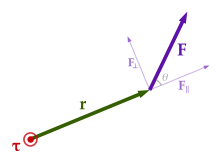Torque is defined as the product of the force applied to an object and the perpendicular distance from the point of application of the force to the axis of rotation. The Torque Calculator is a dedicated tool for the calculation of torque.
Torque Calculator
Results:
| Parameter | Value |
|---|---|
| Lever Arm (r) | [Calculated Value] m |
| Force (F) | [Calculated Value] N |
| Angle (θ) | [Calculated Value] degrees |
| Torque (τ) | [Calculated Value] N·m |
The torque (\( \tau \)) applied to an object is calculated using the formula:
Where:
- \( \tau \) (tau) represents the torque in newton-meters (N·m).
- \( r \) denotes the lever arm, which is the distance from the pivot point to the point where the force is applied, typically measured in meters (m).
- \( F \) represents the force acting on the object, usually measured in newtons (N).
- \( θ \) (theta) represents the angle between the force vector and the lever arm, typically equal to 90 degrees in many cases. However, this formula can be used for any angle measurement as long as it’s in radians.
Torque, often represented by the symbol “τ” (the Greek letter tau), is a fundamental concept in physics and engineering. It is a vector quantity that measures the rotational force or moment applied to an object around an axis. Torque is sometimes referred to as “rotational force” because it causes an object to rotate or twist around a fixed point or axis.

Lets understand the term “Torque”
- Definition: Torque is defined as the product of the force applied to an object and the perpendicular distance from the point of application of the force to the axis of rotation.
- Direction: Torque is a vector quantity, meaning it has both magnitude and direction. The direction of torque is determined by the right-hand rule, where you curl your right-hand fingers in the direction of the force and your thumb points in the direction of the torque.
- Units: The SI unit of torque is the newton-meter (N·m). In other words, one newton-meter of torque is equal to the torque produced when a one-newton force is applied at a perpendicular distance of one meter from the axis of rotation.
- Rotational Effects: Torque is responsible for causing objects to rotate or change their rotational motion. For example, when you use a wrench to tighten a bolt, you apply torque. In vehicles, engines generate torque to make the wheels rotate.
- Leverage: Torque depends not only on the magnitude of the force but also on the lever arm’s length. Increasing the distance from the axis of rotation to the point of application of the force (increasing the lever arm) will increase the torque for a given force.
- Balanced Torques: In equilibrium (no net angular acceleration), the sum of torques acting on an object is zero. This principle is essential in statics and is known as the principle of moments.
Torque plays a crucial role in various fields, including mechanics, engineering, and physics, and is fundamental for understanding the behavior of rotating systems and machinery. It is essential for designing and analyzing mechanical systems, such as engines, gears, and levers.
Thanks for reading the article on Torque Calculator.